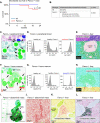Leukemia and chromosomal instability in aged Fancc-/- mice
- PMID: 26860989
- PMCID: PMC5131786
- DOI: 10.1016/j.exphem.2016.01.009
Leukemia and chromosomal instability in aged Fancc-/- mice
Abstract
Fanconi anemia (FA) is an inherited disorder of genomic instability associated with high risk of myelodysplasia and acute myeloid leukemia (AML). Young mice deficient in FA core complex genes do not naturally develop cancer, hampering preclinical studies on malignant hematopoiesis in FA. Here we describe that aging Fancc(-/-) mice are prone to genomically unstable AML and other hematologic neoplasms. We report that aneuploidy precedes malignant transformation during Fancc(-/-) hematopoiesis. Our observations reveal that Fancc(-/-) mice develop hematopoietic chromosomal instability followed by leukemia in an age-dependent manner, recapitulating the clinical phenotype of human FA and providing a proof of concept for future development of preclinical models of FA-associated leukemogenesis.
Copyright © 2016 ISEH - International Society for Experimental Hematology. Published by Elsevier Inc. All rights reserved.
Figures



References
Publication types
MeSH terms
Substances
Grants and funding
LinkOut - more resources
Full Text Sources
Other Literature Sources
Medical
Molecular Biology Databases

